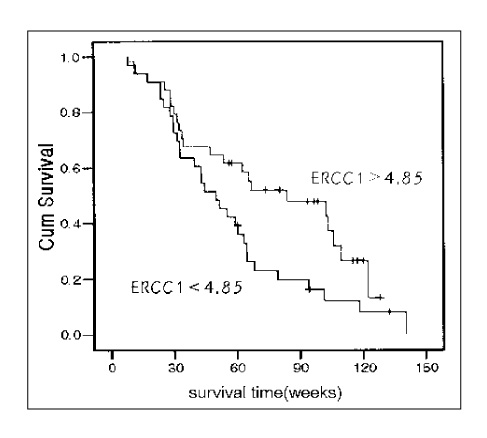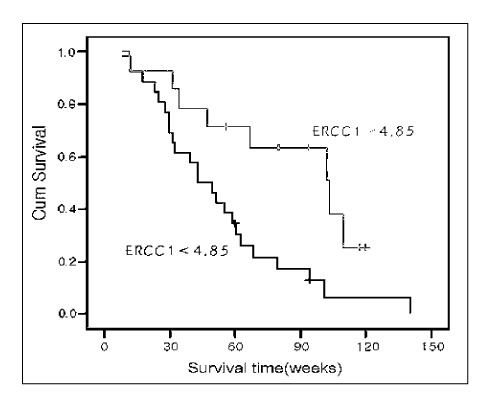Tuberc Respir Dis.
2006 Feb;60(2):151-159.
Relation between ERCC1 Expression in Sputum and Survival after Cisplatin-Based Chemotherapy in Patients with Non-Small Cell Lung Cancer
- Affiliations
-
- 1Department of Internal Medicine, Kosin University, College of Medicine, Korea. jungmh@ns.kosinmed.or.kr
Abstract
-
BACKGROUND: Excision repair cross complementing gene 1 (ERCC1) not only has a protective role against carcinogens, but plays an important role in cisplatin-resistance via the repair of cisplatin-DNA adducts. This study investigated the association between the ERCC1 expression levels in sputum and survival after cisplatin-based chemotherapy in patients with inoperable non-small cell lung cancer (NSCLC).
METHODS
Using the sputum collected from 67 inoperable (stage IIIa-IV) NSCLC patients treated with either taxanes (33 cases) or gemcitabine (34 cases) plus cisplatin, the relative expression levels of ERCC1 and the expression of the tumor specific antigen, MAGE, were examined by the quantitative RT-PCR and RT-PCR, respectively. The response and survival were compared with the relative level of ERCC1 or MAGE expression and the treatment modality.
RESULTS
In the sputum, ERCC1 and MAGE was detected in 74.6% and 40.2% of patients, respectively. Using the median ERCC1 level, the patients were classified as having high or low ERCC1 expression. The median overall survival (MST) was significantly longer in patients with a high ERCC1 expression level than those with a low expression level (84 weeks vs. 44 weeks respectively, P=0.017). In the taxene-based treatment group, the MST was longer than the gemcitabine group (79 weeks vs. 47 weeks, respectively, P=0.03). The levels of ERCC1 were significantly higher in patients who were MAGE-positive (P=0.003). In the MAGE-negative patients, the MST was longer in the high ERCC1 group (103 weeks vs. 43 weeks, P=0.008), but not in the MAGE-positive patients (62 weeks vs. 44 weeks, P=0.348).
CONCLUSION
ERCC1 expression in the sputum can be a prognostic factor for survival after chemotherapy in patients with inoperable NSCLC.
Keyword
MeSH Terms
Figure
Reference
-
1. Death rate by the causes, 2004. Korea National Statistical Office. http://www.kosis.nso.go.kr.2. Scientific Committee of Korean Academy of Tuberculosis and Respiratory Disease. The National Survey of Lung Cancer in Korea. Tuberc Respir Dis. 1999. 46:455–465.3. Bunn PA Jr, Kelly K. New chemotherapeutic agents prolong survival and improve quality of life in non-small cell lung cancer: a review of the literature and future directions. Clin Cancer Res. 1998. 4:1087–1100.4. Schiller JH, Harrington D, Belani CP, Langer C, Sandler A, Krook J, et al. Comparison of four chemotherapy regimens for advanced non-small-cell lung cancer. N Engl J Med. 2002. 346:92–98.5. Carney DN. Lung cancer: time to move on from chemotherapy. N Engl J Med. 2002. 346:126–128.6. Fong KM, Sekido Y, Gazdar AF, Minna JD. Molecular biology of lung cancer: clinical implications. Thorax. 2003. 58:892–900.7. Green MR. Targeting targeted therapy. N Engl J Med. 2004. 350:2191–2193.8. Rosell R, Taron M, Ariza A, Barnadas A, Mate JL, Reguart N, et al. Molecular predictors of response to chemotherapy in lung cancer. Semin Oncol. 2004. 31:Suppl 1. 20–27.9. Hande KR. Lung cancer: principles and practice. 2000. 2nd ed. Philadelphia: Lippincott Williams & Willkins;270–283.10. Butkiewicz D, Rusin M, Enewold L, Shields PG, Chorazy M, Harris CC. Genetic polymorphisms in DNA repair genes and risk of lung cancer. Carcinogenesis. 2001. 22:593–597.11. Spitz MR, Wu X, Wang Y, Wang LE, Shete S, Amos CI, et al. Modulation of nucleotide excision repair capacity by XPD polymorphisms in lung cancer patients. Cancer Res. 2001. 61:1354–1357.12. Reed E. Platinum-DNA adducts, nucleotide excision repair and platinum based anti-cancer chemotherapy. Cancer Treat Rev. 1998. 24:331–344.13. Dabholkar M, Vionnet J, Bostick-Brunton F, Yu JJ, Reed E. Messenger RNA levels of XPAC and ERCC1 in ovarian cancer tissue correlate with response to platinum-based chemotherapy. J Clin Invest. 1994. 94:703–708.14. Lord RV, Brabender J, Gandara D, Alberola V, Camps C, Domine M, et al. Low ERCC1 expression correlates with prolonged survival after cisplatin plus gemcitabine chemotherapy in non-small cell lung cancer. Clin Cancer Res. 2002. 8:2286–2291.15. Ryu JS, Hong YC, Han HS, Lee JE, Kim S, Park YM, et al. Association between polymorphism of ERCC1 and XPD and survival in non-small-cell lung cancer patients treated with cisplatin combination chemotherapy. Lung Cancer. 2004. 44:311–316.16. Zhou W, Gurubhagavatula S, Liu G, Park S, Neuberg DS, Wain JC, et al. Excision repair cross-complementation group 1 polymorphism predicts overall survival in advanced non-small cell lung cancer patients treated with platinum-based chemotherapy. Clin Cancer Res. 2004. 10:4939–4943.17. Bosken CH, Wei Q, Amos CI, Spitz MR. An analysis of DNA repair as a determinant of survival in patients with non-small-cell lung cancer. J Natl Cancer Inst. 2002. 94:1091–1099.18. Yook DS, Shin HS, Choi P, Kim JH, Shin SH, Ok CH, et al. Expression of MAGE in the induced sputum of lung cancer patients. Tuberc Respir Dis. 2002. 53:265–274.19. Jheon S, Hyun DS, Lee SC, Yoon GS, Jeon CH, Park JW, et al. Lung cancer detection by a RT-nested PCR using MAGE AS 1: 6 common primers. Lung Cancer. 2004. 43:29–37.20. Cullinane C, Mazur SJ, Essigmann JM, Phillips DR, Bohr VA. Inhibition of RNA polymerase II transcription in human cell extracts by cisplatin DNA damage. Biochemistry. 1999. 38:6204–6212.21. Metzger R, Leichman CG, Danenberg KD, Danenberg PV, Lenz HJ, Hayashi K, et al. ERCC1 mRNA levels complement thymidylate synthase mRNA levels in predicting response and survival for gastric cancer patients receiving combination cisplatin and fluorouracil chemotherapy. J Clin Oncol. 1998. 16:309–316.22. Shirota Y, Stoehlmacher J, Brabender J, Xiong YP, Uetake H, Danenberg KD, et al. ERCC1 and thymidylate synthase mRNA levels predict survival for colorectal cancer patients receiving combination oxaliplatin and fluorouracil chemotherapy. J Clin Oncol. 2001. 19:4298–4304.23. Keller SM, Adak S, Wagner H, Herskovic A, Komaki R, Brooks BJ, et al. A randomized trial of postoperative adjuvant therapy in patients with completely resected stage II or IIIa non-small-cell lung cancer. N Engl J Med. 2000. 343:1217–1222.24. Depierre A, Milleron B, Moro-Sibilot D, Chevret S, Quoix E, Lebeau B, et al. Preoperative chemotherapy followed by surgery compared with primary surgery in resectable stage I (except T1N0), II, and IIIa non-small-cell lung cancer. J Clin Oncol. 2002. 20:247–253.25. Arriagada R, Bergman B, Dunant A, le Chevalier T, Pignon JP, Vansteenkiste J. Cisplatin-based adjuvant chemotherapy in patients with completely resected non-small-cell lung cancer. N Engl J Med. 2004. 350:351–360.26. Rosell R, Felip E, Taron M, Majo J, Mendez P, Sanchez-Ronco M, et al. Gene expression as a predictive marker of outcome in stage IIB-IIIA-IIIB non-small cell lung cancer after induction gemcitabine-based chemotherapy followed by resectional surgery. Clin Cancer Res. 2004. 10:4215s–4219s.27. Simon GR, Sharma S, Cantor A, Smith P, Bepler G. ERCC1 expression is a predictor of survival in resected patients with non-small cell lung cancer. Chest. 2005. 127:978–983.28. van der Bruggen P, Traversari C, Chomez P, Lurquin C, de Plaen E, van den Eynde B, et al. A gene encoding an antigen recognized by cytolytic T lymphocytes on a human melanoma. Science. 1991. 254:1643–1647.29. de Plaen E, Arden K, Traversari C, Gaforio JJ, Szikora JP, de Smet C, et al. Structure, chromosomal localization, and expression of 12 genes of the MAGE family. Immunogenetics. 1994. 40:360–369.30. Lynch TJ, Bell DW, Sordella R, Gurubhagavatula S, Okimoto RA, Brannigan BW, et al. Activating mutations in the epidermal growth factor receptor underlying responsiveness of non-small-cell lung cancer to gefitinib. N Engl J Med. 2004. 350:2129–2139.
- Full Text Links
- Actions
-
Cited
- CITED
-
- Close
- Share
- Similar articles
-
- ERCC1 Expression-Based Randomized Phase II Study of Gemcitabine/Cisplatin Versus Irinotecan/Cisplatin in Patients with Advanced Non-small Cell Lung Cancer
- Chemotherapy for Small Cell Lung Cancer
- An Analysis of HER-2/neu, ERCC1, and GST-pi in Advanced Non-Small Cell Lung Cancer Patients Who are Treated with Platinum-based Chemotherapy
- Increased ERCC Expression Correlates with Improved Outcome of Patients Treated with Cisplatin as an Adjuvant Therapy for Curatively Resected Gastric Cancer
- Predictive Value of the ERCC1 Expression for Treatment Response and Survival in Advanced Gastric Cancer Patients Receiving Cisplatin-based First-line Chemotherapy



